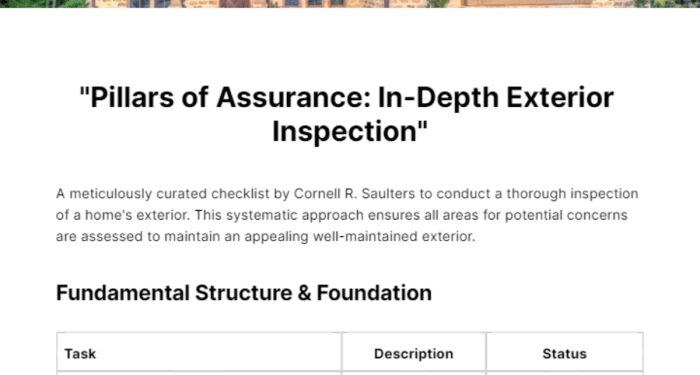Embarking on the journey of Exterior Contractor Checklist for Home Safety Inspection, this initial segment aims to draw in and captivate the audience, setting the stage for a detailed exploration of the topic.
Delving into the specifics of what comprises a comprehensive safety inspection for homes, we uncover the critical components that ensure a secure and hazard-free living space.
Importance of Home Safety Inspections by Exterior Contractors
Regular safety inspections conducted by exterior contractors play a crucial role in ensuring the well-being of homeowners and their families. These inspections help identify potential hazards that could lead to accidents or injuries if left unaddressed. By proactively assessing the exterior of a home, contractors can prevent dangerous situations and create a safe living environment for residents.
Examples of Potential Hazards
- Cracked or damaged roofing materials that could result in leaks or collapses
- Loose or missing siding that may expose the interior of the home to weather elements
- Improperly installed or damaged gutters that could lead to water damage or flooding
- Uneven or damaged walkways and driveways posing tripping hazards
- Overgrown trees or branches near the home that could fall and cause damage
Preventing Accidents and Ensuring Safety
Through regular safety inspections, exterior contractors can detect these hazards early on and take the necessary steps to address them. By repairing or replacing damaged materials, fixing structural issues, and maintaining the exterior of the home, contractors help prevent accidents and create a safe living environment for homeowners.
These inspections not only protect the property but also ensure the well-being of those residing in the home.
Exterior Contractor Checklist Components
When conducting a home safety inspection, exterior contractors need to consider various essential components to ensure the overall safety and well-being of the residents. These components cover different aspects of the home, including structural integrity, electrical systems, and outdoor hazards.
Structural Integrity
- Inspect the roof for any signs of damage or wear that could lead to leaks or structural issues.
- Check the foundation for cracks or shifting that may compromise the stability of the home.
- Examine exterior walls for any damage, such as water stains or rot, which could indicate issues with insulation or structural integrity.
Electrical Systems
- Test all outdoor outlets and ensure they are properly sealed to prevent water damage.
- Inspect the condition of outdoor lighting fixtures to ensure they are functioning correctly and safely.
- Check for any exposed wiring or overloaded circuits that could pose a fire hazard.
Outdoor Hazards
- Survey the landscape for any overgrown trees or branches that could potentially damage the home during a storm.
- Check the condition of walkways, driveways, and stairs for any tripping hazards or uneven surfaces.
- Inspect outdoor structures, such as decks and patios, for signs of wear or damage that could compromise safety.
Structural Integrity Assessment
When exterior contractors conduct a structural integrity assessment of a home, they focus on examining key areas that are crucial for the overall stability and safety of the property. By carefully inspecting the roof, walls, foundation, and windows, contractors can identify any potential issues that may compromise the structural integrity of the home.
Roof
- Contractors will inspect the condition of the roof shingles or tiles to check for any signs of damage or wear.
- They will also assess the flashing around chimneys, vents, and skylights to ensure they are properly sealed and watertight.
- Checking for any sagging or uneven areas on the roof that may indicate structural issues is also a key focus during the assessment.
Walls
- Contractors will examine the exterior walls for cracks, bulges, or signs of water damage that could weaken the structural integrity of the home.
- They will also look for any gaps or separations between the walls and windows or doors that may indicate shifting or settling of the foundation.
- Inspecting the siding or stucco for any signs of deterioration or pest infestations is crucial to prevent further damage.
Foundation
- Assessing the foundation for cracks, shifts, or uneven settling is essential to ensure the overall stability of the home.
- Contractors will look for signs of water intrusion or moisture that could compromise the foundation's integrity over time.
- Checking the basement or crawl space for any structural issues, such as bowing walls or uneven floors, is also part of the assessment.
Windows
- Inspecting the window frames for rot, decay, or damage that may affect their structural integrity and energy efficiency is a key aspect of the assessment.
- Checking for proper sealing around the windows to prevent drafts, leaks, or moisture intrusion is crucial for maintaining the integrity of the home.
- Examining the operation of windows to ensure they open, close, and lock securely is important for both safety and structural stability.
Electrical System Evaluation
During a home safety inspection, evaluating the electrical system is crucial to ensure the overall safety of the property. Exterior contractors play a vital role in identifying potential hazards and addressing them to prevent any electrical-related incidents.
Wiring Issues Assessment
Exterior contractors carefully inspect the wiring throughout the property to check for any signs of wear and tear, damage, or outdated components. They look for exposed wires, frayed insulation, and improper connections that could lead to electrical malfunctions or even fires.
Circuit Overload Detection
Contractors also assess the electrical panel and circuits to determine if there are any instances of overload. Circuit overloads can pose a significant risk as they can cause overheating and potentially start a fire. By checking the load on each circuit, contractors can ensure that the electrical system is balanced and not at risk of overloading.
Fire Hazard Prevention
To address potential fire hazards related to the electrical system, contractors may recommend installing ground fault circuit interrupters (GFCIs) in areas prone to moisture, such as bathrooms and kitchens. GFCIs help prevent electrical shocks and reduce the risk of electrical fires.
Outdoor Hazards Identification

When it comes to outdoor hazards, exterior contractors pay close attention to potential risks that can compromise the safety of a home. From landscaping features to outdoor structures, identifying and addressing these hazards is crucial for maintaining a secure environment for homeowners and their families.
Landscaping Hazards
- Overgrown vegetation: Exterior contractors look for any overgrown trees, shrubs, or bushes that may obstruct pathways or pose a risk of falling branches.
- Uneven terrain: Inspectors assess the landscape for uneven surfaces, such as hills or slopes, that could result in trips or falls.
- Potential pests: They also keep an eye out for signs of pests like termites or rodents that can cause damage to the home's exterior.
Pathways and Driveways
- Cracks and potholes: Contractors check for cracks and potholes in pathways and driveways that can cause tripping hazards or damage vehicles.
- Proper lighting: Adequate lighting along pathways and driveways is essential for visibility and safety, especially during nighttime.
- Slippery surfaces: They also look for surfaces that may become slippery when wet, such as moss-covered walkways or driveways.
Outdoor Structures Assessment
- Fence stability: Contractors inspect fences for stability and any signs of damage that could compromise security or safety.
- Deck condition: They assess the condition of decks, looking for rot, loose boards, or other structural issues that could lead to accidents.
- Gutter maintenance: Inspectors check gutters for debris buildup or damage to ensure proper drainage and prevent water damage.
Ultimate Conclusion
Concluding our discussion on Exterior Contractor Checklist for Home Safety Inspection, it's evident that regular inspections by professionals play a vital role in maintaining a safe and sound home environment. By addressing structural integrity, electrical systems, and outdoor hazards, homeowners can proactively prevent accidents and promote overall safety.
Commonly Asked Questions
What are some examples of potential hazards identified during home safety inspections?
Examples include faulty wiring, roof leaks, and deteriorating foundation that can pose safety risks if not addressed promptly.
How can homeowners address outdoor hazards identified by exterior contractors?
Homeowners can mitigate outdoor hazards by maintaining clear pathways, ensuring proper drainage, and securing outdoor structures like fences and decks.
What safety measures can be implemented to address electrical concerns in a home?
Safety measures include updating wiring, installing surge protectors, and ensuring proper grounding to reduce the risk of electrical fires and accidents.











